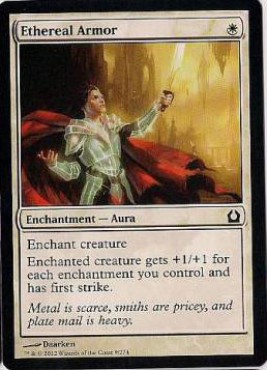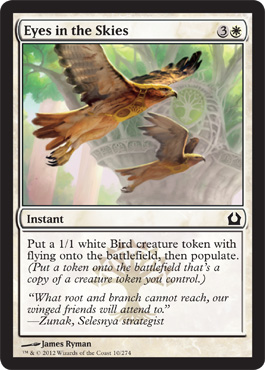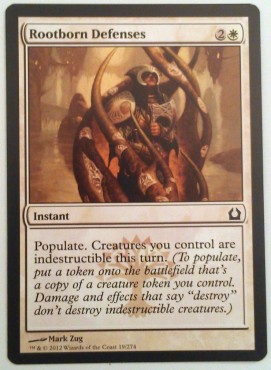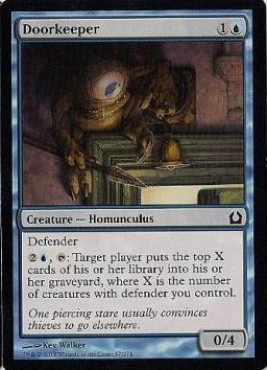With Return to Ravnica just around the corner, as well as that awkward time on Magic Online where the real world gets to play with cards we do not have yet, I would like to do my share of speculating and brewing with what Return to Ravnica brings to Pauper.
Aura you ready?
I’d like to start out with what is essentially Pauper’s Armored Ascension for 1 mana, especially when combined with a mana base of Forests and Abundant Growth, Utopia Sprawl, and Wild Growth. With access to these “enchantment lands,” the two cards play out in a very similar way, where the card naturally gets bigger as you develop your mana base, which is something that you would have been doing already. This is what makes Ethereal Armor such a promising card in Pauper. Because the overall power level of commons is reduced since the “New World Order” (which is discussed in full detail here), a majority of the commons have lackluster effects or require you to jump through major hoops or set-up intricate, fragile combos to pull off something interesting. Fortunately for the sake of change, Ethereal Armor breaks that mold by offering a fairly powerful effect at 1 mana that rewards you for doing that which you were going to do anyway.
It is somewhat interesting why this is so, that is, why is it possible for design to intentionally cut the power level of commons and still release something that has the power level of Ethereal Armor (aside from mistakes or oversights like Delver of Secrets. The reason has to do with the Limited environment and the tools which make this particular card so effective. In Limited, the environment for which this card was likely particularly designed, the card is simple, that is, not complex, but also is not completely overpowered and format-skewing because the benefit of it requires also playing a bunch of enchantments. This means that Armor in Limited requires playing a ton of enchantments (which nobody ever really wants to do) and hence also having a massive number of enchantments in your deck (and there are likely not enough good enchantments for this to be a good strategy). However, when combined with the “Enchant land” cards, this card easily becomes quite strong. It is a similar situation, in principle at least, to Stoneforge Mystic in Standard before Scars Block, where the card saw virtually no play, not because it wasn’t a good card, but because Standard did not have the tools to effectively capitalize on what the card wanted to do (at least until Swords and Batterskull showed up). While I certainly don’t see the DCI banning Ethereal Armor in Pauper anytime soon, I think that it is interesting to see how some power cards can make their way into Pauper even after the overall power level of commons was significantly cut.
But anyway, the next step is finding a home for Ethereal Armor, and, to make this step much easier, I think that the GW Aura deck that occasionally sees some fringe play with decent results can definitely make use of this card. For those unfamiliar with the deck, it is based around playing Aura Gnarlid, Ancestral Mask, and now Ethereal Armor in conjunction with some other Auras and cheap hexproof creatures such as Slippery Bogle, Gladecover Scout, or Silhana Ledgewalker. This gives you a big creature that is difficult to remove that you can turn sideways each turn until your opponent is dead (the quintessential green deck).
The first question is whether or not the deck even wants another Aura-based pump spell in Ethereal Armor, especially since Ancestral Mask essentially does the same thing. The answer is most definitely yes. Above all, adding redundancy to whatever a deck is trying to do is almost always an improvement, and this is especially true in a deck where the redundant cards are cumulative. That is, redundancy can be bad when you have multiple copies of a card that accomplish nothing more than the first copy of the card; however, with regard to Masks and Armors, an additional copy is always welcome, since it just makes the creature bigger, and each additional Aura increases the bonus from earlier Auras. In addition to this, it only costs 1 mana, so it is less taxing on the curve than some of the other Auras which could make their way into the deck.
The next step is to figure out which other Auras ought to be included to make our hexproof guys, gals, and whatever the Bogle is, bigger. Naturally, the premier Aura is Armadillo Cloak which is often the namesake card of the deck. Giving a large creature trample and lifelink makes it near impossible for you to lose a race. It is also worth pointing out that Armadillo Cloak’s “lifelink” does not actually give the creature lifelink and the effect is triggered by the copy of Cloak, so multiple copies of Cloak on a single creature will gain you life that many times (and Cloak, in this way, also can count as a makeshift conditional removal spell for an opponent’s creature). But aside from Cloak, the choices become less obvious, ranging from the go-to good enchantments like Rancor to more obscure but still effective things like Snake Umbra or Petrified Plating. Considering the fact that this deck does’t really plan on having creatures dying often enough to use Rancor effectively, I prefer to pass on that. So without further ado, here is my draft of the GW Aura deck with the inclusion of Ethereal Armor:
GW Auras by Mike Radzwilla
|
| ||||||||
One final note on this deck is that while this is a fairly traditional list, access to Utopia Sprawl and Abundant Growth (as well as Prophetic Prism and Evolving Wilds if necessary) allows the deck to branch into a variety of colors without requiring an unstable manabase. This can also make Totem-Guide Hartebeest a pretty effective toolbox, especially when you can splash other colors.
Populate
As you may or may not know, Sprout Swarm is one of my favorite cards it Pauper. There is something magical in creating an army of 1/1 tokens that completely muddle up the board and outnumber and swarm (you know, as the name implies) the opponent. There is something to be said of a card that can generate a 50-for-1. Needless to say, I was excited to see what everyone’s favorite token-producing guild Selesnya would bring to the format. Among the populating cards at common, the following stand out as being potentially playable:
It’s a shame that there is no permanent at common (yet) which can populate, that can potentially be developed into an archetype in Pauper, but that does not mean that some tricks are not available. There are quite a few token producers at common, but I believe that in order to justify populating, the tokens needs to be bigger than just a 1/1 goblin, solider, saproling, or squirrel. Populating Eldrazi spawns is also completely out of question. However, looking through the list of token-producing Pauper cards, some stand out as ideal targets for reproducing:
At this point, the deck can go in two directions. The first is the safe and stable route, where the populate mechanic is used with average green token-producing cards to make more moderately-sized tokens. The other option is to populate with 6/1 Shroud creatures (populate does not target) and 7/1 hasty tramplers. Considering the fact that Rootborn Defense has synergy with x/1 guys (aside from the one who exiles himself), you definitely have some interesting interactions that are worth building around.
The obvious problem here is the manabase, which is really going to limit the deck to two colors, or two colors with a splash at best. As with the previous deck, running the enchantment land-fixers is an option here as well to lessen the burden of splash colors, but doing this also reduces the opportunity to trigger Landfall on Zektar Shrine.
On the other hand, going with Deadly Grub makes for a slower, and also more vulnerable deck since Grub can be killed in a variety of ways, even if with a bigger payoff. Shroud creatures are difficult, if not impossible, for most decks to deal with outside of just blocking and trading with the 6/1, which becomes difficult when you start making multiple copies of it.
With these considerations in mind, I would like to focus today on populating the 7/1 Elemental token and building an aggressive deck around it:
Pauperulate by Mike Radzwilla
|
| ||||||||
While I do not know if the populate mechanic is going to be powerful enough to have a meaningful impact on the Pauper metagame, I am nonetheless looking forward to trying out the mechanic to see how it performs with the many token producers in Pauper.
UG Defender
I must admit the embarrassing fact that I love durdling and have an unnatural affinity for decks which simultaneously do everything and nothing. And more often than not, this brings me into blue and green, which are the ideal durdle colors, since you have blue to draw as many cards as you want and green to cast as much as you want. My other secret ambition is to build a functioning mill deck in Pauper that doesn’t flop without finding Jaces Erasure. This brings me to Doorkeeper.
Never before has durdling been so appealing to me. This is also complemented by new cards such as Axebane Guardian and Gatekeeper Vine, as well as old favorites such as Overgrown Battlement, Wall of Roots, and Vine Trellis (though I don’t think Trellis ever made anyone’s favorite list).
And, the single strangest card that can actually make UG Defender a cohesive strategy?
So, as a starting point, this deck partially operates like Mono-G Ramp, in which the early game is spent ramping up to its larger threats, and this can still be an angle through which this deck can attack. Ideally, the mana can ramp into an early Ulamogs Crusher or Capsize (courtesy of Axebane Guardian’s color fixing) to take control of the game. Conversely, this deck can rely on Doorkeeper, and potentially other mill effects such as Curse of the Bloody Tome to have an edge in the control matchups.
My starting point for such a deck looks like this:
UG Defender by Mike Radzwilla
|
| ||||||||
Of all of the potential Pauper decks to come out of Return to Ravnica, this is the one I am most excited to sleeve up (if you can call it that on MTGO). Unlike the previous lists, which were very tight in the focus of what the deck was trying to accomplish, this one is fairly open-ended, really only requiring that things have defender and are either blue or green. Because of this, there are a bunch of directions which this deck can take. Assuredly there will be many which I have currently overlooked.
For the most part, the choices ought to make sense and be pretty typical with the exceptions of Essence Warden and Relic of Progenitus. The theory behind Essence Warden is that it, combined with Wall of Kelp, gives you a way to recover from early aggressive pushes as well as a way to stop them from beating you down with a single evasion creature (as a lone Guardian of the Guildpact is known to do). The other choice which should be a little surprising is the inclusion of Relic of Progenitus. This is essentially a concession to Mnemonic Wall, which is the bane of a mill strategy. Nothing is worse than milling all of a Post deck’s win conditions, only to have them fetch back a Rolling Thunder and hit you for 97. They are also incidentally good against Tortured Existence decks and Mystical Teachings, though these are less important considerations since Tortured Existence decks only see fringe play and a lot of milling makes Teachings worse by disrupting its toolbox (since the things it would search from the deck go to the graveyard).
All in all, I am really excited to try out this deck, since it seems like it definitely has the potential to be competitive. It has a way to establish itself early against aggressive decks, effectively fight Cloudpost through mill, and attack all decks through multiple angles, such as ramping into something larger or grinding out their deck.
Maybe when we finally get to Ravnica, I can durdle my way to a dream.
Conclusion
All in all, I think Return to Ravnica has a bunch of interesting things that have potential to make their way into the world of Pauper, many of which were not mentioned in this article. Among these are the new dual lands, which are also bound to have an enormous effect on improving Pauper manabases, but that is speculation for another time. As always, thank you for reading my article, and I look forward to your thoughts and responses in the comments below.






Hi there. The Decks look fine but I have 2 Questions about the Enchantment-Deck.
First: Where is Rancor? It´s one of the best enchantments green can have and gets your 10/10 ledgewalker through the cloud of faires and such.
Second: What about Fertile Growth. It just fits the theme but it costs 2…so maybe it´s to slow for it.
Also is there a possibility to contact you. I´m getting into Pauper right now and would like to hit you with 1 or 2 of my current decks I´m testing if possible.
And not to forget: Thanks for the content you provide for us!
I’m not a big fan of the aura deck or populating (mostly personal preference … I don’t really like attacking) but they seem like fun times.
The mill deck though, totally have to agree about durdling and defenders – if only because when you’re winning you get to spend so much longer winning
And any deck rocking Wall of Kelp as one of its main engines is just too cool for words.
Thanks for the comments!
Snorri, the man reason I did not include Rancor was because of the space, but I don’t think it was necessarily correct to leave it out. Part of my thinking was that unlike in Infect and Stompy, this deck does not really plan on having creatures die often, so you rarely get to benefit from multiple uses of it. But even without getting multiple uses out of it, +2/+0 and trample for one green is strong, so the deck should probably include a few copies. I do think that the main reason to play it is for the trample, and once a creature has trample (either with Rancor or an Armadillo Cloak), the other copies of Rancor are significantly less effective. Anyway, I think it can definitely be included in place of a combination of Aura Gnarlids, Crystalizations, or Snake Umbra.
And to be honest, I completely forgot about Fertile Growth. It can definitely replace Wild Growth, or something else, depending on how much the mana base needs help. Thank you for pointing that out.
Pixie, I’m glad you like the UG deck too. From the brainstorming I’ve done with it (no pun intended), it seems like it may potentially be a viable deck. I’m really looking forward to testing this one out in particular.
Also, Snorri, my MTGO username is ThePolkaMan. Feel free to add me as a buddy and send me a message whenever I am online.
“Complemented.”
1. Add to (something) in a way that enhances or improves it; make perfect.
2. Add to or make complete.
Complimented means something else. FWIW
fixed!
How does the mill deck test out? I’m looking forward to sleeve it myself.
Just tried out the aura deck a few times in casual games on mtgo and so far it’s absolutely filthy. Ethereal Armour is a fantastic addition too.
And agree w/ Snorri on Rancor. Cut 1 each of Gnarlid, Crystallization and Snake Umbra to try out 3 rancor.